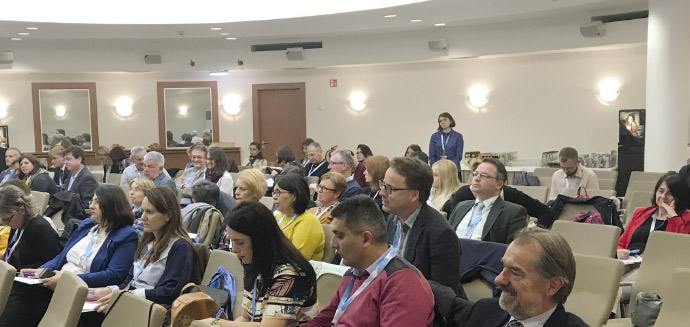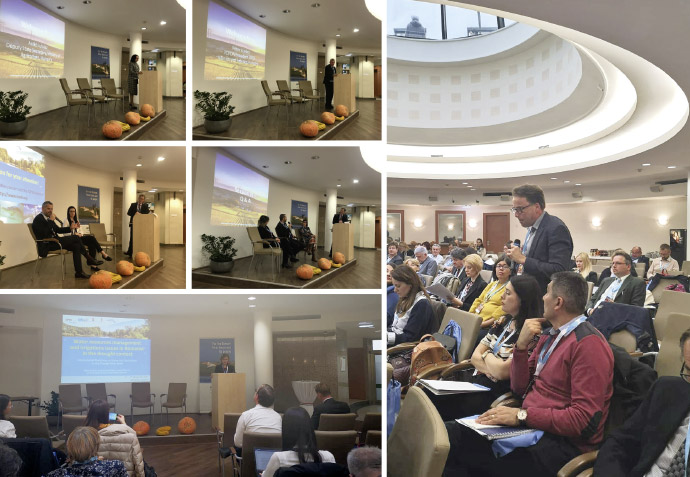Danube Watch 3/2019 - From Convention to Action
Water and Agriculture Workshop - Budapest, 6th -7th November 2019


O n the 6th and 7th of November this year, the ICPDR jointly organised and held a conference in Budapest on water and agriculture in the Danube River Basin together with the Hungarian Ministry of Interior, the Hungarian Ministry of Agriculture and the Danube Strategy Priority Area 4. During the conference, many experts were able to present information on a range of subjects related to agriculture and discuss views with their peers in organised work-groups.
From the beginning, the idea of the conference was to bring these experts from the agriculture and water sectors together along with relevant stakeholders in order to share ideas and thoughts on better alignment between the two sectorial policies, exchange good examples and experiences on sustainable agricultural practices and provide input for the finalisation of a guidance document on sustainable agriculture. This guidance document is meant to aid Danube countries in the preparation and implementation of their national agri-environmental policies, CAP Strategic Plans and relevant strategies related to their River Basin Management Plans.
Over the two days, presentations and discussions were divided into thematic blocks to provide a greater focus on important topics relating to the over-arching concept of sustainable agriculture within the DRB. The first day consisted of several key introductory statements, thematic presentations to provide a general background, followed by specified presentations on issues relating to nutrient management, drought issues and the concepts of science and innovation in agriculture. These were then followed by moderated rotating “breakout group” discussions on these three main issues: nutrients, drought and science/ innovation.
The idea behind the breakout group sessions was to provide the conference participants the opportunity to more thoroughly discuss these topics based on the day's presentations as well as their own knowledge base. With sessions and groups rotated after 45 minute discussions, all were afforded the chance to offer their own unique insight as well as broaden their understanding based on that of others including the experts who had provided more in-depth presentations on the subjects earlier. In preparation for the group discussions, conference participants had been asked to consider three key questions:
- What are the key needs and core interests of both the water and agriculture sectors in your region?
- What do you see as the main future challenges facing the two sectors as we enter 2020?
- What goals need to be met and which actions might be needed for the situation to improve?
The second day of the event was structured a bit differently. Whereas the first day addressed the challenges in the water and agriculture sectors, the second day was dedicated to conclusions. The rapporteurs of the breakout sessions brought details back on each of the three pillars. The main findings of the sessions were reported to the audience followed by a moderated discussion and feedback session. This allowed for even further expansion upon previous smaller group discourse with greater input from a wider base as well as the addition of a full evening's time for thought and reflection.
The final thoughts on the three main concepts were also laid out on the second day, focusing on needs, challenges and solutions. Within the nutrients group, some key needs highlighted were win-win solutions, dialogue, knowledge and communication and research. Challenges included the discharge of pollutants, coordination and erosion control. A few potential solutions suggested were advisory services, sustainability-based solutions and monitoring.
The drought group thought that, among others, securing food and agriculture production in times of drought and food quality were important needs. Challenges included the adaptation of measures by member states, knowledge sharing and smart dialogue with farmers about their role. Many solutions were thought up. Among them were improved cooperation between sectors, improved knowledge sharing and for all member nations to have a drought action plan in place.
Lack of integrated projects and those with a holistic approach as well as a lack of practical implementation of project results were some of the problems thought up in the science/innovation group. Suggested solutions were better synchronisation and coordination of projects and better communication with farmers, including access to translators. Participants recommended that water managers should try to come to the events where the farmers meet and speak with them personally and vice versa because dialogue is very important.
In addition, two presentations provided good examples and outlook for further steps and potential solutions. Specifically, on aligning water and agriculture policies, followed by a short question and answer session relating to the topic. The theme of better communication between all stakeholders remained very much in focus, driving home its importance at all levels.
A final session was held that acted to highlight the proposed Guidance Document on sustainable Agriculture. After a presentation providing a background introduction to the document, time was provided for discussion amongst the attendees and for all feedback to be voiced and collected. This allowed all to reflect on what was said, what needs to be done and what concrete steps are necessary to finalise the ICPDR guidance document on sustainable agriculture as well as to get from the concept to the implementation stage. Prior to the conference, participants were again asked to consider several questions in order to be prepared for this specific session:
- What needs to be improved, changed or added for the final version?
- How can the document be made more attractive to policy makers?
- How can this document help us to reach relevant agriculture stakeholders?
The success of the conference was in the exchange of ideas and dialogue that was fostered which allowed technical experts and stakeholders to better understand various ideas and views on the future of sustainable agriculture in the Danube River Basin. This applies to the future and what needs to be done in order to ensure the continued betterment and preservation of the region's waterways.







